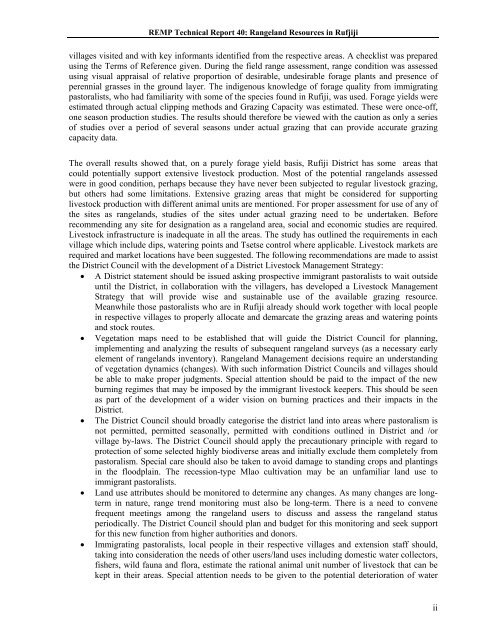rufiji environment management project - Coastal Forests of Kenya ...
rufiji environment management project - Coastal Forests of Kenya ...
rufiji environment management project - Coastal Forests of Kenya ...
You also want an ePaper? Increase the reach of your titles
YUMPU automatically turns print PDFs into web optimized ePapers that Google loves.
REMP Technical Report 40: Rangeland Resources in Rufjiji<br />
villages visited and with key informants identified from the respective areas. A checklist was prepared<br />
using the Terms <strong>of</strong> Reference given. During the field range assessment, range condition was assessed<br />
using visual appraisal <strong>of</strong> relative proportion <strong>of</strong> desirable, undesirable forage plants and presence <strong>of</strong><br />
perennial grasses in the ground layer. The indigenous knowledge <strong>of</strong> forage quality from immigrating<br />
pastoralists, who had familiarity with some <strong>of</strong> the species found in Rufiji, was used. Forage yields were<br />
estimated through actual clipping methods and Grazing Capacity was estimated. These were once-<strong>of</strong>f,<br />
one season production studies. The results should therefore be viewed with the caution as only a series<br />
<strong>of</strong> studies over a period <strong>of</strong> several seasons under actual grazing that can provide accurate grazing<br />
capacity data.<br />
The overall results showed that, on a purely forage yield basis, Rufiji District has some areas that<br />
could potentially support extensive livestock production. Most <strong>of</strong> the potential rangelands assessed<br />
were in good condition, perhaps because they have never been subjected to regular livestock grazing,<br />
but others had some limitations. Extensive grazing areas that might be considered for supporting<br />
livestock production with different animal units are mentioned. For proper assessment for use <strong>of</strong> any <strong>of</strong><br />
the sites as rangelands, studies <strong>of</strong> the sites under actual grazing need to be undertaken. Before<br />
recommending any site for designation as a rangeland area, social and economic studies are required.<br />
Livestock infrastructure is inadequate in all the areas. The study has outlined the requirements in each<br />
village which include dips, watering points and Tsetse control where applicable. Livestock markets are<br />
required and market locations have been suggested. The following recommendations are made to assist<br />
the District Council with the development <strong>of</strong> a District Livestock Management Strategy:<br />
• A District statement should be issued asking prospective immigrant pastoralists to wait outside<br />
until the District, in collaboration with the villagers, has developed a Livestock Management<br />
Strategy that will provide wise and sustainable use <strong>of</strong> the available grazing resource.<br />
Meanwhile those pastoralists who are in Rufiji already should work together with local people<br />
in respective villages to properly allocate and demarcate the grazing areas and watering points<br />
and stock routes.<br />
• Vegetation maps need to be established that will guide the District Council for planning,<br />
implementing and analyzing the results <strong>of</strong> subsequent rangeland surveys (as a necessary early<br />
element <strong>of</strong> rangelands inventory). Rangeland Management decisions require an understanding<br />
<strong>of</strong> vegetation dynamics (changes). With such information District Councils and villages should<br />
be able to make proper judgments. Special attention should be paid to the impact <strong>of</strong> the new<br />
burning regimes that may be imposed by the immigrant livestock keepers. This should be seen<br />
as part <strong>of</strong> the development <strong>of</strong> a wider vision on burning practices and their impacts in the<br />
District.<br />
• The District Council should broadly categorise the district land into areas where pastoralism is<br />
not permitted, permitted seasonally, permitted with conditions outlined in District and /or<br />
village by-laws. The District Council should apply the precautionary principle with regard to<br />
protection <strong>of</strong> some selected highly biodiverse areas and initially exclude them completely from<br />
pastoralism. Special care should also be taken to avoid damage to standing crops and plantings<br />
in the floodplain. The recession-type Mlao cultivation may be an unfamiliar land use to<br />
immigrant pastoralists.<br />
• Land use attributes should be monitored to determine any changes. As many changes are longterm<br />
in nature, range trend monitoring must also be long-term. There is a need to convene<br />
frequent meetings among the rangeland users to discuss and assess the rangeland status<br />
periodically. The District Council should plan and budget for this monitoring and seek support<br />
for this new function from higher authorities and donors.<br />
• Immigrating pastoralists, local people in their respective villages and extension staff should,<br />
taking into consideration the needs <strong>of</strong> other users/land uses including domestic water collectors,<br />
fishers, wild fauna and flora, estimate the rational animal unit number <strong>of</strong> livestock that can be<br />
kept in their areas. Special attention needs to be given to the potential deterioration <strong>of</strong> water<br />
ii

















